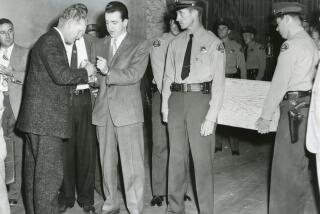‘Self-Convicted’ Murderer of Girl Paid Full Price
- Share via
SAN FRANCISCO — Doomed by massive circumstantial evidence in a sensational trial, mild-mannered Burton W. Abbott paid with his life 30 years ago for the bludgeon murder of 14-year-old Stephanie Bryan.
Abbott, a shy-appearing tubercular who showed the world a dour man with high purpose, gasped his last in the San Quentin gas chamber without confessing he had killed the youngster.
But the jury did not believe the righteous picture Abbott painted of himself. And they did not appreciate his sneering laughter as the prosecutor grilled him on the witness stand.
Both sides said later Abbott all but convicted himself.
Reporter’s Discovery
The jurors were convinced that Abbott grabbed the victim from a Berkeley street April 28, 1955, drove her to his mountain cabin, strangled her with her panties, smashed her skull and buried her body.
The body was discovered by now-retired San Francisco Examiner reporter Ed Montgomery, who currently is writing a book about his exploits in that case and others.
Montgomery won the 1951 Pulitzer Prize for reporting after his work in uncovering a shakedown by IRS agents.
From the beginning, the Abbott case was awash in mystery, and remained so even as the deadly pellets dropped into a vat of acid, says Montgomery.
“There were almost no clues available to police,” Montgomery writes. “The girl had started home with a girlfriend after school . . . she never arrived.”
Evidence in Basement
Three months of intensive police efforts failed. Then, Abbott’s wife, Georgia, triggered the events that led her spouse to the apple-green prison chamber and a cloud of cyanide.
“Georgia went down into the basement of their home to hunt for something out of which to make a costume for an upcoming party. . . . Instead, she found in a box of old clothing a black wallet--Stephanie Bryan’s wallet,” recalls Montgomery.
The police were called in. The Abbott house had been used as an election polling place, so anyone could have dumped the wallet. But police then dug up some of the Abbott basement and found one of Stephanie’s textbooks.
“Throughout the questioning Burton Abbott remained calm and unperturbed. He denied any knowledge as to how they got into his basement,” says the reporter.
Abbott denied even being in Berkeley the day the girl disappeared. He said he was at the family cabin nearly 300 miles north in Trinity County. A small army of deputies, the FBI and assorted other officers spent days on the property digging holes. They found nothing.
Montgomery’s paper sent him and a photographer to search. They tramped the grounds long after dark.
“We were just about to call it off when we got a whiff of a body,” said Montgomery. A further search failed, and the pair finally decided they needed some hunting dogs.
Soon, they were all over the Abbott property behind a pack of baying hounds.
“We went down to where we had experienced the odor,” said Montgomery. “The dogs suddenly stopped dead in their tracks and turned their muzzles to the west.”
Beneath a clump of manzanita, they found the decomposed body of Stephanie Bryan.
The jury found Abbott guilty of kidnaping and murder. His appeals failed, and he died March 15, 1957.
One final mystery was played out even as the fumes rose.
At the side of the gas chamber, the hot line to then Gov. Goodwin Knight in Sacramento started buzzing insistently.
“Hold the execution!” screamed a Knight aide over the phone.
“Too late,” replied Warden Harley Teets, looking over to watch Abbott die. The futile bid to stay the execution for one hour was never explained.
More to Read
Sign up for Essential California
The most important California stories and recommendations in your inbox every morning.
You may occasionally receive promotional content from the Los Angeles Times.













